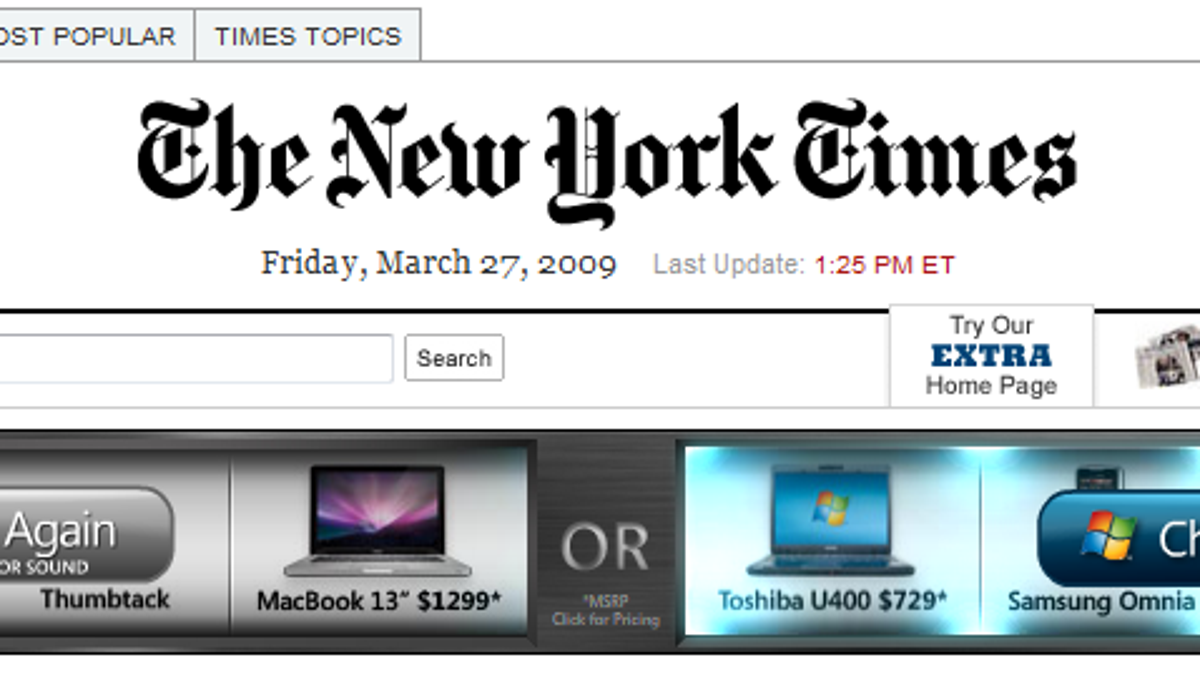Microsoft goes after Apple online too
In an ad on major news Web sites (for now, those of the Times and the Journal), Microsoft tries to hammer home Windows PCs' price advantage over Macs.

After launching its most direct TV assault yet on Apple, Microsoft is extending the battle onto the Web.
The software maker has launched an online spot, in which Web surfers spin a wheel and compare what they can buy for the same amount of money. In each case, users can get a Mac and, say, pocket lint, or they can get a PC and two other things of value.
In one "spin," a user is told they can choose from a shoelace, pen cap, and MacBook, or get a Lenovo Y530, a photo scanner, and pair of Supras (I didn't know what they were either, but apparently they are some hip skater shoes).
David Webster, a general manager in Microsoft's central marketing unit, said that while some people are enticed by lower prices alone, some like to think of value in terms of what else they could spend that money on. In the online campaign, Microsoft tries to play up those things.
Webster said Microsoft is also trying to play up the variety of the PC marketplace, saying a customer is likely to get "a better fit" with Windows.
"If you want a machine with racing stripes and lights and a Blu-ray drive, we've got it," he said. "If you want a PC that's 2.5 pounds and that's still got an optical drive, we've got it. That contrasts with a different story on the other side of the fence."
Microsoft is clearly taking a page directly from Apple's "Get a Mac" campaign. Even the placement of the ad itself and its chrome look of the spinning buttons make it look like an Apple ad.
The online campaign, which is on the front of the New York Times and Wall Street Journal Web sites on Friday, complements the TV ad that debuted on Thursday (see embedded video below).
Webster acknowledged those places precisely because they are the places Apple had been running its own ads.
It's the latest in a series of direct attacks on Apple, which have included recent comments from CEO Steve Ballmer, as well as Microsoft's "Apple Tax" PR campaign.
As for the TV campaign, Webster said Microsoft placed a Craigslist ad looking for people aiming to spend a certain amount on their computer. It told respondents it was a market research firm looking to follow computer buyers through their buying experience.
Webster said the deck was not stacked against Apple. "As you will see in subsequent spots, these are customers that have $1,500 or $2,000 to spend, where clearly, they could have chosen Apple, if that's what they wanted to do," Webster said. "We were pretty thoughtful and picking price points that might have been met by an Apple."
As Webster's comment indicates, Microsoft isn't stopping with the red-headed Lauren, who starred in the first spot. The software maker said it followed around about 10 PC buyers, and plans to spotlight four or five of those experiences (though Webster tells me that none of the 10 bought Macs).
"You will see those over the coming weeks," Webster said. Incidentally, Webster is the man who came up with the idea that became Microsoft's Mojave Project, in which people blind-tested Windows Vista.
As for Lauren, Microsoft says she was a real PC buyer, even though she is also an aspiring actress. Webster said Microsoft only learned about her acting ambition in the process of filming the piece and added that the ad segments were filmed in Los Angeles.
"Most waiters and baristas (there) tend to have Screen Actors Guild cards, from what I am told," he said.
Microsoft has gone in a variety of directions with its Windows ads, beginning with the Jerry Seinfeld-Bill Gates spots last fall and continuing with the "I'm a PC" campaign and most recently the "Rookies" spots, which featured kids using Windows Live Photo Gallery.
Webster said Microsoft is pleased with its series of ads, even if they have received only mixed feedback from the blogosphere.
"Obviously, people in the blogosphere and in comments sections will come to their own conclusions, but that doesn't bother us because at the end of the day, we look at the numbers," he said.
Webster said Microsoft's internal research has shown a 10 percent increase in the number of people who say they will buy a Windows PC when they buy their next computer, though he would not say what percentage have that intent.